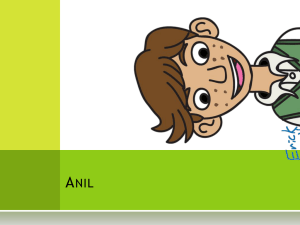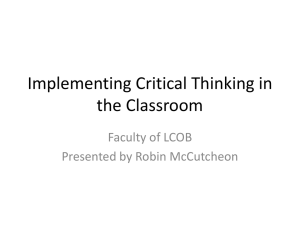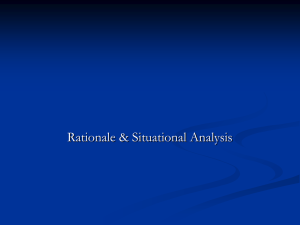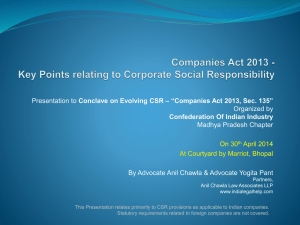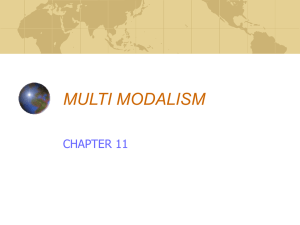Traffic Introduction
advertisement
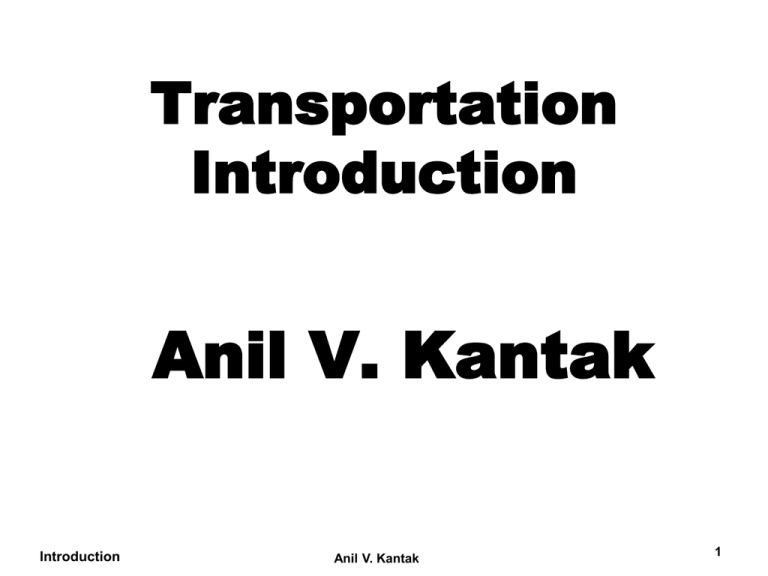
Transportation Introduction Anil V. Kantak Introduction Anil V. Kantak 1 •Transportation System: Transportation system consists of: •Fixed facilities •The flow entities •Control system Transportation system allows people and goods to overcome friction of geographic space (going from point A to point B) efficiently to participate in a timely manner in some activity. •Fixed Facilities: These are physical components of the Introduction Anil V. Kantak 2 system that are fixed in space and constitute network of links. Fixed facilities include the roadways, railway tracks, pipes etc. They also include intersections, transit terminals, interchanges, harbors and airports. Construction of the fixed facilities is a subject of civil engineering. •Flow Entities: Flow entities are units that traverse fixed facilities. They include vehicles, container units, cars, railroad cars etc. In case of highways (freeways) as a fixed facility it is expected accommodate a wide variety of Introduction Anil V. Kantak 3 vehicle types, ranging from motor bicycles to larger tractor trailer combinations. CONTROL SYSTEM VEHICULAR CONTROL FLOW CONTROL The control system consists of vehicular control and flow control that keeps the people achieve their activity goals. •Vehicular Control: This refers to the method and technology used to guide individual vehicles on the fixed facilities 4 Introduction Anil V. Kantak to achieve a particular goal. Vehicular control must incorporate in it the proper geometric design of fixed facilities in addition to the vehicular attributes. • Flow Control: This refers to method that permits the efficient and smooth operation of streams of the vehicles. The method also minimizes conflicts between vehicles. This system includes various types of signing, marking, and the signal systems and the underlying rules of their operation. Introduction Anil V. Kantak 5 •Transportation Demand: Demand for transportation is either derived or indirect. Transportation systems are generated to serve transportation needs of community. Community needs to go to school, college, work, shopping, visiting people etc. This creates demand of transportation. All these activities have a schedule to fit to. Community needs to efficiently supply for these needs. Efficiently means a balance between needs and cost of construction, environmental effects, convenience, etc. Many different types of professional such as social scientist and psychiatrists are needed to strike the right balance. 6 Introduction Anil V. Kantak • Transportation System Classifications: Transportation systems may be classified according to: •Type of Technology Used •Gasoline •Diesel •Electric Flow Entities •Combination •Cement Concrete •Tar •Combination Introduction Fixed Facilities Anil V. Kantak 7 •Type of Service They Provide: •Goods Transport •Community Needs •School •Shopping •General Transportation needs •Ownership / Responsibility of Operation and Maintenance All these different ways of looking at the transportation system are necessary when making different types of transportation related decisions. Introduction Anil V. Kantak 8 Transportation systems can also be characterized according to medium on which flow elements of the system are supported. These are commonly referred as modes. •Land Transportation •Highways, Roads, Streets etc. •Rail Roads. •Air Transportation •Domestic •International •Water Transportation •Inland Introduction Anil V. Kantak 9 •Coastal •Ocean •Pipe Lines •Oil •Gas •Other Transportation services are classified as •For hire (also called “Public”): The name refers to their availability to general public as well as to private parties and does not refer to their ownership. E.g., the public bus system may be publicly owned or privately owned but it is available to the general public as well10 Introduction Anil V. Kantak as private parties alike. •Not for Hire (Also called “Private”) •Common Carrier •Contract Carrier •Mass Transportation (Also called Mass Transit) This usually refers to common carriage of passengers such as taxis, car rentals etc. •Urban Transportation Systems: •Pedestrian Oriented (Initial modern era) •Water Based (Only a few places have it) •Animal Driven (Earlier centuries) •Rail Supported Electric Streetcars Introduction Anil V. Kantak 11 • Commuter Railroads (From city to city) • Heavy Rail Rapid Transit System • Underground rail system • Internal Combustion Engine • Ignition Compression Engines • Compression Ignition Engines • Busses and Automobiles Some terms in development of public transport system • Rapid Transit: Refers to all exclusive right of way systems • Fixed Guide way Transit: This is a 12 Introductionsystem in which Anil V.the Kantak vehicles are fixed to This includes all monorail systems and two rail (dual rail) systems. The system may or may not have an operator on board. •Articulated Systems: These are systems in which flow units can be connected to form trains. An articulated bus is two buses connected together with a flexible joint. This arrangement is called “Bandy Bus”. •Dual Mode Systems: Systems in which vehicles can operate in manual control mode or an automatic mode. •Demand Responsive Systems: System that employ flexibility in route or time scheduling to respond to actualAnildemand placed on them.13 Introduction V. Kantak •Role of Government: It is an organization consisting of rules of conduct, the collective decision making process and enforcing the rules that attempt to impart social and economic order and to maintain a cohesiveness of the society. •transportation system provides connectivity between activity centers that enhances interaction between people. •Advances in transportation system spurs evolution of civilization. In ancient times also the cities developed near or around transportation routes, nodes etc. for commerce. Introduction Anil V. Kantak 14 •Transportation is key to industrialization. The raw material need to be brought to factories and then the product of factories need to be distributed to the world. •Because of the profound role transportation plays in the society, government have always become involved in the provision, operation, and regulation of transportation systems through the establishment of public planning processes. Introduction Anil V. Kantak 15 The specific actions of a government and method by which it chooses to implement these actions reflect the contemporary values system of the society it represents. •Instruments of Government Involvement Government intervenes in market place to accomplish objectives that are in public’s interest. These methods of government intervention are: •Soft Promotion: This refers to attempts made by government to encourage or to discourage certain situations without legally requiring them to do so. Introduction Anil V. Kantak 16 e.g., an advertising campaign favoring car pooling to reduce rush hour congestion and a reduced energy consumption. •Regulation: This refers to those government actions that place legal requirements on individuals in public interest. An example of this is the seat belt law in the state of California, engine efficiency standards to reduce pollution in the environment. •Investment: This involves the financial support , public financing or even public ownership of various Introduction Anil V. Kantak 17 systems or services. Subsides to privately owned services to ensure service to mobility disadvantaged group. •Tools and Applications: •Need Basic Sciences •Mathematics •Computer Programming •Applications are served by these things •Well Informed Decision Making •Practical Approximation •Changing the System Design as more Experience is Gained •Clear Understanding of the Problem Introduction Anil V. Kantak 18 Mathematical Models: Engineers employ models to study and analyze the system of concern. MODELS PHYSICAL STATIC DYNAMIC MATHEMATICAL STATIC DYNAMIC ANALYTIC ANALYTIC NUMERIC NUMERIC SIMULATION Introduction Anil V. Kantak 19 Models represent a part of reality in some manner. Static models represent the structure of a system while dynamic models represent structure of a system as well as incorporate a representation of the system’s process, the way in which the system changes over time. Models are abstraction of systems they represent. Since they are approximation of the system, a number of models for the system may exist. Selection of the model of system must strike a balance between ease of application and degree of reality Introduction Anil V. Kantak 20 represented by the model. As an example, motion of a body can be well modeled by Newtonian mechanics, however modeling the motion of a particle in a particle accelerator may need the Einstein’s theory of relativity. •Components of Mathematical Models: Mathematical model can have one of many forms linear, non-linear, exponential, logarithmic, differential, integral etc. One needs to postulate the model which is simply selecting a mathematical form. Consider the following mathematical model: Introduction Anil V. Kantak 21 Y aX Z W b c d X, Z, and Z are called the independent variables. They can take any values in the given set of values. Once the X, Z, and W are decided and the constants a, b, and c are given values, Y can be evaluated. Y is called the dependent variable. The constants a, b, and, c are called the parameter of the model. Model Calibration: This is the process by which numerical values of the parameters of the model are determined. This is many times done by using statistical methods and is dependent on the 22 Introduction Anil V. Kantak Experimental knowledge of the dependent and independent variables of the model. I = 1, 2, …,N experiments are done to obtain Xi, Yi, Zi, and Wi values. These are used to evaluate parameters that will yield the same value for observed dependent variable Yi. Model Validation: This refers to testing of a calibrated model using empirical data other than those used for calibration. If the model bears out then it may be used. If it does not then some changes may need to be implemented. Even if the model is changed, the model may still be useful but in a limited way. 23 Introduction Anil V. Kantak •Transportation Models: The transportation system involves a physical phenomenon, the motion of the flow entities on the fixed facilities. Since human presence is there inevitably, the model should account for the human behavior and human factor. The lines of demarcation between human factor and human behavior and human factor is not very clear, human behavior is in a continuous state of flux and is influenced by the technological changes. Introduction Anil V. Kantak 24
